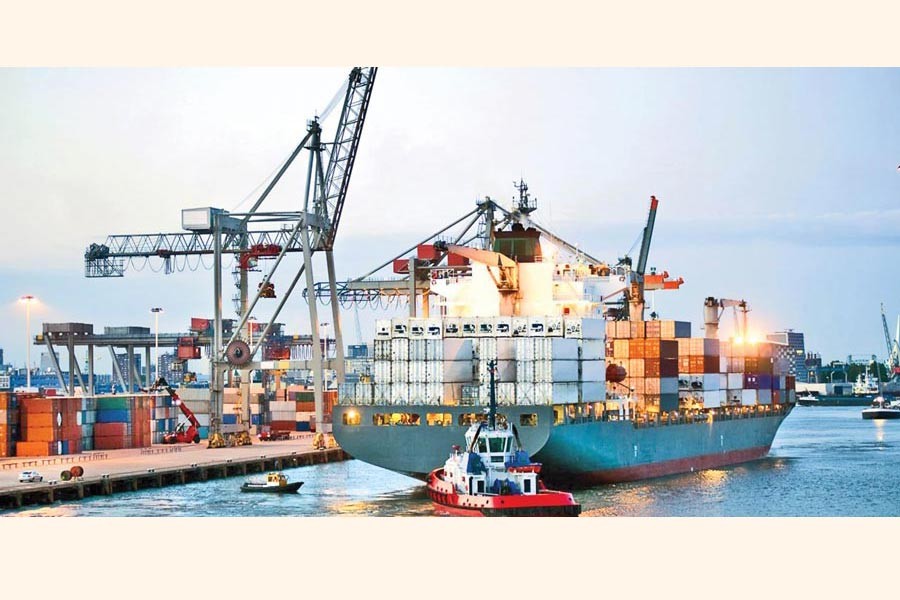
Chattogram, Mongla ports use
How win-win is the deal with India?
Focus on Chattogram
Pankaj Dastider | Tuesday, 11 December 2018

 In the light of an agreement signed on October 25, India will use Chattogram and Mongla ports of Bangladesh for the movement of goods to and from India. Two neighbouring countries signed it in a Shipping Secretary-level meeting in New Delhi. A Standard Operating Procedure (SOP) was also signed for the movement of passenger and cruise services, in addition to the signing of addendum to 'Protocol on Inland Water Transit and Trade' (PIWTT) between the two neighbouring countries. Earlier, the cabinet had given its seal of approval for the proposed agreement.
In the light of an agreement signed on October 25, India will use Chattogram and Mongla ports of Bangladesh for the movement of goods to and from India. Two neighbouring countries signed it in a Shipping Secretary-level meeting in New Delhi. A Standard Operating Procedure (SOP) was also signed for the movement of passenger and cruise services, in addition to the signing of addendum to 'Protocol on Inland Water Transit and Trade' (PIWTT) between the two neighbouring countries. Earlier, the cabinet had given its seal of approval for the proposed agreement.
Under the deal, Bangladesh would allow India to use the Chattogram and Mongla ports for freight transportation to the latter's land-locked north-eastern region, which will enhance the sub-regional connectivity. Bangladeshi vehicles will transship goods from these two ports to the border points of India and also the other way round. The transshipment will be guided by the rules of the WTO (World Trade Organisation), and customs regulations and duties on the products will be applicable as those in practice in Bangladesh. These provisions will help make the agreement win-win for both.
A report published in the Financial Express said the local shippers are pressing the government to use two Indian ports to transport both export and import cargoes to and from any third country. Citing the chronic problem of tailback on the Chattogram-Dhaka highway as a major problem, the Dhaka-based shippers have been pressing the government for months to allow them to use Kolkata and Haldia ports.
But the government looked reluctant to agree to their proposal as the high-ups in the government took into consideration the possible impact of letting shippers use the Indian ports. The government has now decided to employ Bangladesh Institute of Development Studies (BIDS) and the Bangladesh Foreign Trade Institute (BFTI), two state think-tanks, to examine pros and cons of the uses of Kolkata and Haldia ports by Bangladesh businesses.
When some of the businesses, trade body leaders and policy researchers hailed the move as good news because it will bring good business opportunity by the mobilisation of some additional revenue and turning the Chattogram port into one like Singapore, there are others, who express concern about the existing capacity of the prime sea port -- Chittagong Port, and urged the authorities concerned to strengthen its infrastructure capacity to make good use of the opportunity of the deal. They said that Singapore became rich by providing such transshipment facility.
At the same time, critics said it will affect our manufacturing sector as we export a lot of goods to seven north-eastern states of India. As there is no barrier to India using Chattogram and Mongla ports, the neighbouring country will transport its goods to the north-eastern region from other parts of the country by using our ports and territory. At the moment, Bangladesh's trade with India's Seven Sister states, such as Assam, Arunachal, Nagaland, Mizoram, Meghalaya, Monipur and Tripura, is increasing and this may be adversely affected with the agreement facilitating mainland India's trade with its landlocked region.
Professor Sikandar Khan, Vice Chancellor of East Delta University, said Chattogram port is itself plagued with multiple problems as the importers and exporters are facing congestion of containers and vessels every now and then. How can a port that fails to cope with its local demand provide services to others? Ok, India will help us transporting cargo and we will also do it. Before that we must enhance our port capacity. Unless the capacity is enhanced our local businesses will be facing troubles. The businesses are yet to keep trust on the existing facilities of the ports in Bangladesh.
He said roads and highways of the country have not been adequately developed either. Our highways and roads are not so developed to bear extra load and pressure of the Indian heavy trucks. In the past, the Indian cargo-laden trucks damaged our roads. So, we should wait until we can develop adequate transportation facilities for use of the ports of two countries.
Chairman of the BSRM Group of Companies Alihussain Akberali said we are going to develop the Bay Container Terminal of Chattogram Port Authority and development work in the Mongla Port have also started, which will take a positive shape in a few years from now. We have given transit facilities in these two ports to India. We have our own ports to handle all cargoes of the country and the facilities must be developed on a priority basis.
He said that the construction of the Bay Container Terminal should have started seven years back as we were told by the Chattogram Port Authority and the government. I don't know why the local administration takes three years' time for land acquisition of the project. It is unfortunate that the BCT construction work has not started yet. However, once our Bay Terminal is constructed and the Mongla port is developed we don't need to use India's Kolkata and Haldia ports.
Hailing the agreement, President of the Chittagong Chamber of Commerce and Industry Mahbubul Alam said the deal is a "very good move" of the government and it will obviously benefit Bangladesh in enhancing the sub-regional connectivity. Bangladesh will get a good amount of levy through use of the ports. The deal will open up windows of bilateral trade boost-up with the seven sister states of India. He said the existing trade imbalance, which is in favour of the seven states, will be reduced in future. But we need to strengthen our jetty facilities. We need at least 60 jetties of the Chattogram Port to cater to the growing needs of national import and export.
Nurul Quayyum Khan, President of the Bangladesh Inland Container Depots Association (BICDA) and Chairman of the QNS Container Services Ltd, termed the deal a "very good bilateral step." He said Bangladesh stands to benefit from getting a good amount of revenue when India uses Chattogram and Mongla ports. India will also benefit equally. The transportation of cargo to the north-eastern seven states of India will be cost-effective. Now we have to take two measures to make the agreement a success. Dredging of the coastal rivers in the northeast of India is required to be accomplished to ensure smooth plying of the vessels. At the same time, the road transportation system between the two countries needs to be expanded.
Commenting on the transshipment deal, Managing Director of the Well Group Syed Shirajul Islam said Bangladesh has nothing to gain from the agreement in which India has offered us to use Kolkata and Haldia Ports. He said the handling capacity of Chittagong Port is currently over 70 million tonnes a year. The demand for cargo handling is growing annually at 14-15 per cent and it is estimated that the demand will grow over 150 million after 12 to 14 years.
What we need is the urgent construction of the Bay Container Terminal. The Chittagong Port Authority is all set to start construction of the extended BCT of the port. Besides, the government has to take up the deep sea port construction project at Matarbari or Sonadia, considering the geo-political and strategic importance of Chattogram and Bangladesh.
He said Kolkata and Haldia are the auxiliary ports while Chattogram, Mumbai, Karachi and Yangon are the main ports. Apart from Kolkata and Haldia, there are other auxiliary ports in the region, such as Hyderabad, Bhubaneshar, Chennai, Mongla and Akiab. The auxiliary ports will function when the main ports fail to work. Haldia is an auxiliary and dead port. Why should I go to Haldia leaving Chittagong? Chittagong Port can serve the purpose of 1600 million people of the region if the Matarbari deep sea port and Bay Terminal are built on a 'first track' basis.
Due to its geo-political and strategic importance, Chattogram remains a very important location and the port can play a pivotal role in the sea transportation of cargo as a transshipment facility for the north-eastern seven states of India, Nepal and Bhutan. A cargo-laden truck can reach Agartala from Chittagong Port in four to five hours. So, Chittagong Port's capacity enhancement is necessary for both Bangladesh and India.
Local businesses, experts and trade body leaders observed that the capacities of both the Chattogram and Mongla ports in handling cargo efficiently are limited. Chattogram port is struggling to meet the growing demand from the importers and exporters and have undertaken some major infrastructure projects and cargo handling equipment procurement schemes in 2017 and 2018. The port handled over 70 million tonnes of cargo, including 2,808,554 TEUs (20 foot equivalent units) of containers during the last fiscal year, 12.19 per cent up over that of the previous year. The port authority is constructing the Patenga Container Terminal (PCT) and has started construction work on the much-awaited Bay Container Terminal (BCT) alongside initiatives to build up Laldiarchar Multipurpose Terminal (LMT) and Karnaphuli Container Terminal (KCT).
After many years, the port has procured six quay gantry cranes recently and the equipment installed in the New Mooring Container Terminal (NCT) has already revved up productivity in container handling. With the commissioning of six new shore-to-ship gantry cranes, the turnaround time of the container ships in the NCT has come down to 48 hours from the earlier 72 hours.